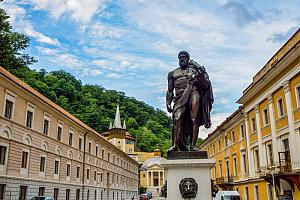Making the case for Băile Govora: The team working to give this historic Romanian resort a chance to shine again
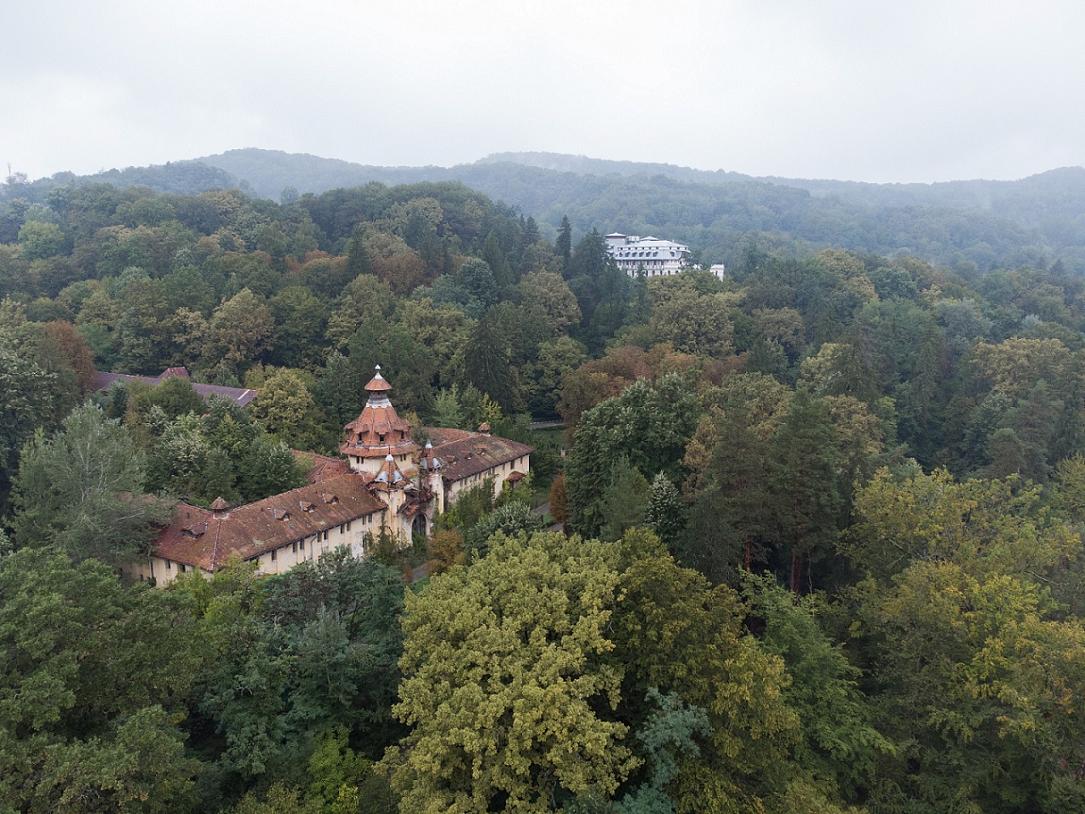
Băile Govora, a historic balneary resort in Vâlcea county, in the region of Oltenia, is getting a chance at seeing its built heritage preserved and restored and its potential for development spotlighted as a multidisciplinary team, Studiogovora, is focusing on its neglected riches.
Băile Govora (Govora Baths) was set up as a public health resort in the late 19th century, as the waters in the area, rich in sulfur and iodine, attracted interest. Its thermal neighborhood was built in the early 20th century, and the resort's touristic development followed. After 1945, the resort, like many of its kind, saw the arrival of state-subsidized mass tourism. Interest in the resort faded gradually after 1989, with only a few small businesses and hotels still active there. Now, the interdisciplinary collective Studiogovora is convinced that this "is an ideal town frozen in time that needs to reinvent itself and its rich cultural heritage can form the basis for its new identity."
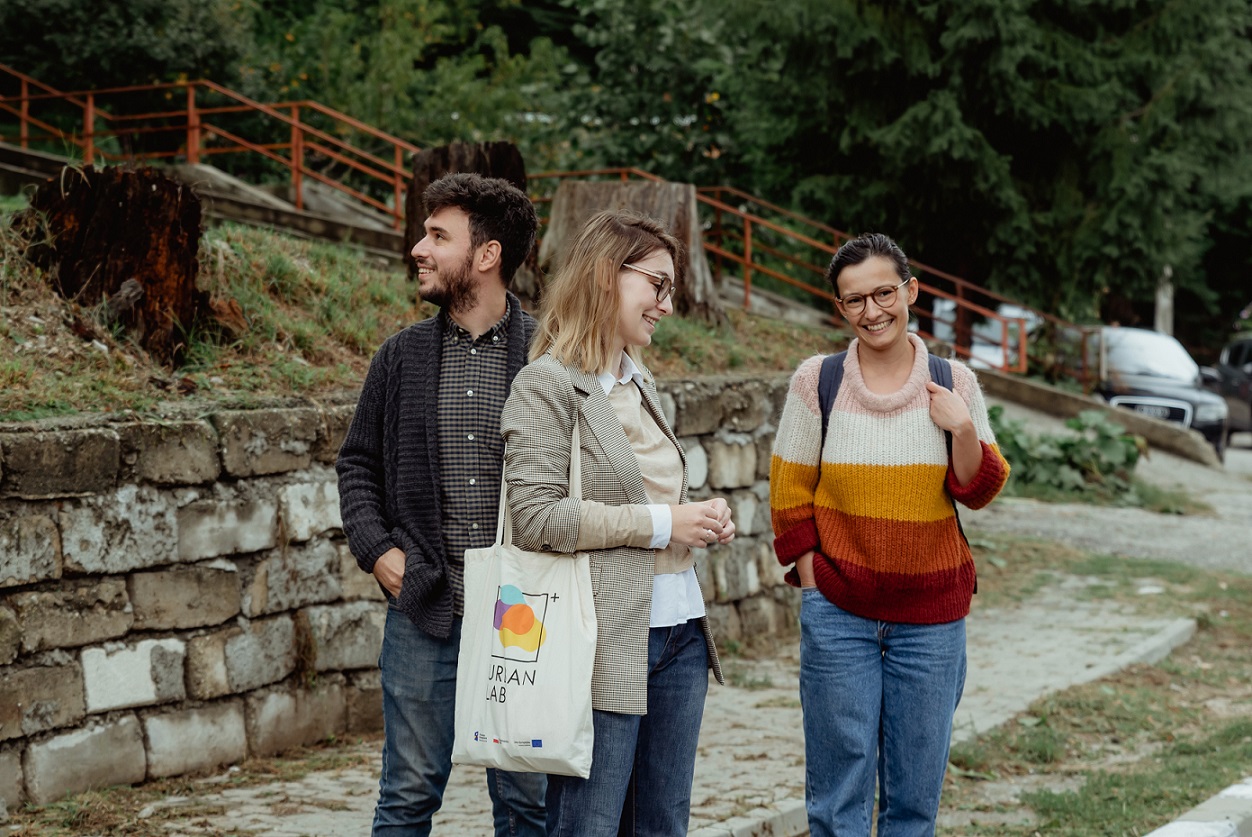
Studiogovora, the team working with various stakeholders to preserve the heritage of the small balneary resort, started with an Instagram account in 2018, when Stefania Hîrleață and Radu Tîrcă, then architecture students, started posting snippets from their walks around Govora, excited by the potential of the buildings, but frustrated about their current state. They chose Băile Govora as their research subject for their diploma work and looked closely at the history of the place and its architectural characteristics and "how the heritage of Romanian thermal resorts became so neglected." At the end of 2019, they were joined by art historian and cultural manager Irina Leca, and soon started working on projects to aimed at breathing new life into the resort.
The collective's first intervention was the restoration of the resort's only historical gazebo preserved to date. Built in 1938, it was degraded and in a fragile state, but following the intervention, it serves as a meeting space for the local community. Another objective was the preservation of the Ivanovici Villa, one of the buildings dating back to the founding of the resort, and preventing its collapse. The villa has "a complex system of wooden verandas, valuable elements characteristic of Romanian spa architecture." The team has also designed a best practices guide for those carrying out interventions to the buildings in the resort and began organizing the yearly event Govora Spa Architecture Days, which gets both locals and tourists involved in cultural activities that make use of the resort's public spaces, especially around historic buildings.
In the email exchange below, the team of Studiogovora - Ștefania Hîrleață, Radu Tîrcă, Irina Leca, and Catinca Mănăilă – detail their projects, some of the challenges of working in the heritage sector, and what they hope the resort can become.
I have read that Studiogovora started as a research project during your student years. Could you tell us a bit more about this? How was the team established? What did starting the project entail?
Studiogovora started with an Instagram account in 2018, where Radu [Tîrcă] and Stefania [Hîrleață] were posting snippets from their walks around Govora, excited by the potential of the buildings but frustrated about their current state. Then, starting with their diploma work (they both graduated from the Faculty of Architecture in 2019), they chose Băile Govora as their research subject and delved deeper into the history of the place, the architectural specificity and how the heritage of Romanian thermal resorts became so neglected. They began to study how Govora evolved, where the architectural influences came from and what was the context in which the whole settlement was built, identifying the valuable buildings and their history. As enthusiastic students, they took part in many architectural competitions, and this is how they connected with the situation of the resort - Băile Govora was an imaginary stage for all kinds of projects. At the end of 2019, Irina Leca, an art historian and cultural manager, who already had experience in the public and non-profit sector, joined us. Irina had visited Govora in 2018, when she worked at the National Heritage Institute, and was fascinated by the potential of the place, so ideas quickly began to be translated into projects that would get Baile Govora back on its feet.
Starting from the critical situation of the resort and the desire to mobilize the local community, but also motivated by the desire to win funding for our ideas, we developed a strategy of which ideas could work in the short and medium term and which would be better left to solidify further. That's how we managed to get off to a strong start, with two worksites in 2020 and a spa heritage event, which will reach its fourth edition this summer.

The project of revitalizing the heritage of Băile Govora means, among others, working with the local authorities and the local community. How has this process been so far? Where were the challenges/ unexpected situations? What type of support did you receive?
Challenges arise when we need external support - either financial or from the authorities, for example in using the tools and ideas we develop. We have become better at negotiating, finding solutions and accepting that every idea or project has its time, and that there is plenty of time.
The first projects - the intervention for Villa Ivanovici, the gazebo, the first edition of the Days of Spa Architecture - started in the middle of a pandemic and an election year. Which for us meant that we periodically had to rethink our activities, depending on health restrictions, and in addition, we had to start working with a reluctant community, who believed that our actions were politically motivated and that they were just promises that would not be put into practice. The fact that Radu and his family are from Govora, part of the community, helped us a lot to get people's trust in such a small town. Probably if we were all outsiders, we would have been received with more reluctance.
Băile Govora is a small town of about 2000 inhabitants with all the surrounding villages, where civicism and community involvement in public life have decreased in recent years, especially with the change of generations, the departure of young people and economic difficulties. There is a visible gap between the active population, who mostly work outside the town and put pressure on the local government, and those who depend on the local authorities for their livelihoods and shy away from criticism.
The city's cultural heritage issues need a lot of involvement and a proactive, strong administration with a lot of capacity to monitor buildings, to think up projects and actively seek funding sources, to be able to co-finance and coordinate large projects. Unfortunately, there are not enough staff with this profile, nor the possibility to hire new ones. The shrinking population does not allow for the growth of the town hall apparatus, and the very small annual budget makes it almost impossible to contract external expertise. In addition, there is a need for a vision for the city's development that is based on well-thought-out plans and strategies and backed up by action on the ground. With local problems in authorizing construction and monitoring the legality of interventions, we cannot yet speak of coherent and predictable development in line with the vision described in the Local Development Strategy.
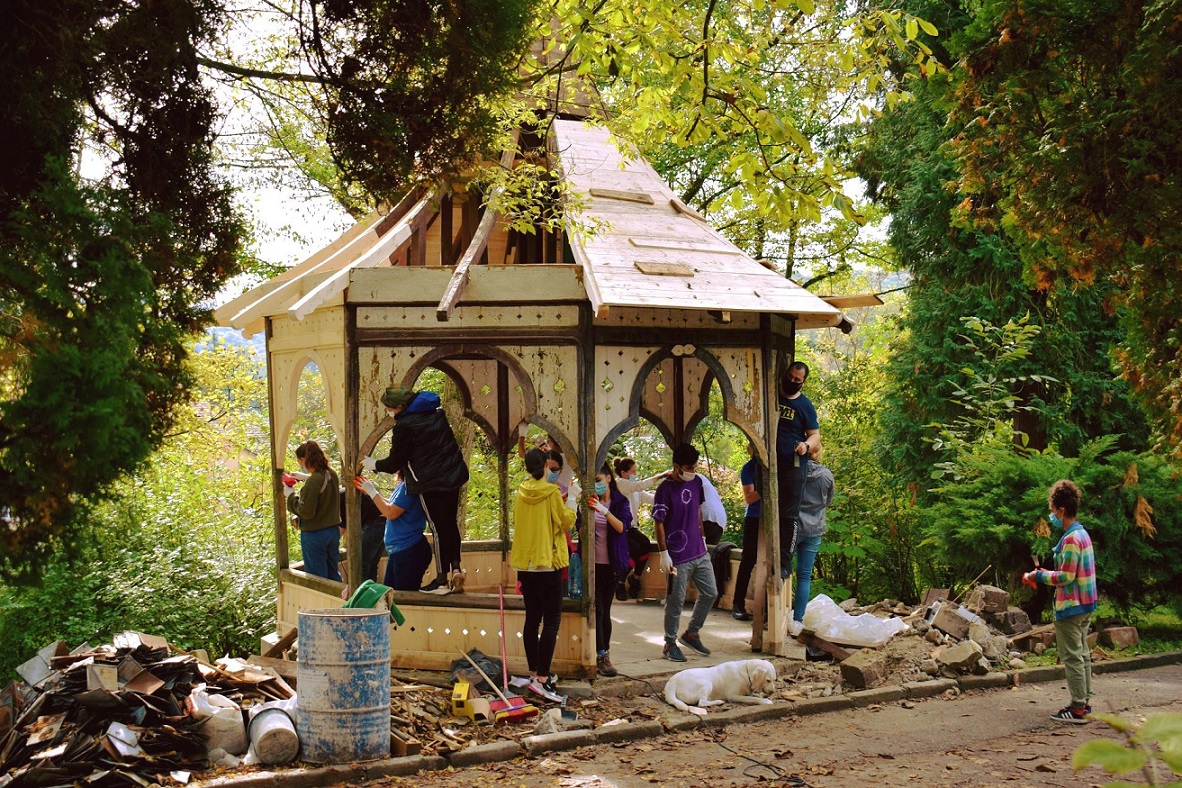
What can you tell us about the restoration of the historic gazebo? What did the process entail?
The first step was to figure out how to intervene, which wasn't easy. We could have remade it from the ground up, brand new, but it wouldn't have remained a historical landmark. We set out to restore it, keeping everything that could be reused, working on site and not dismantling it because old wood is a difficult material to reassemble. The satisfaction is even greater now that the gazebo looks neat, but the structure remains original.
Then came the stabilization of the platform, for which we had to lift the wooden structure. If you didn't get a chance to see it, the gazebo sits in a narrow alley surrounded by trees. Not exactly the right place for a crane, which the budget didn't allow either. So we and the craftsmen resorted to a rudimentary technique - we suspended it for a few days with ropes and pegs.
As for the wood, the master here was Alin Tănasă - Blajin, who set up his temporary workshop in the villa across the lane and worked on the missing pieces. The wood had to be carefully stripped, and here we had help from volunteers, thanks to the Zâmbete Colorate Association. Once cleaned and grouted, the wood was painted green, just as it was at the beginning (we knew the original color by paying attention to the old layers of paint).
Coming back to the platform, finishing it by bush-hammering was another story; here we were helped by Pro Patrimonio's Forgotten Plastering guide and the advice of architect Petru Mortu, who explained the historical recipe step by step. We are glad that the team of builders coordinated by Florin Andreescu wanted to learn traditional techniques and that we could contribute to the exchange of know-how.
Then came the roof, which was rebuilt using the same inter-war technique, whereby each roof scale was handmade. Many thanks to the Damila team for their patience and help.
All the builders involved in the restoration process of this small structure are aware of the opportunity that a specialization in restoration offers and stressed that Băile Govora has a lot of potential in this respect. The buildings in Govora are a resource through which the restoration market in the region would gain more experience and skilled local craftsmen, helping the heritage in a wider area.
Funding was provided through grants from the Romanian Order of Architects, AFCN, Vȃlcea Community Foundation, private donors and our own funds when we exceeded budget.
As the gazebo belongs to the city, the Town Hall needs to update both the inventory value of the building and its type - at the moment, the gazebo is listed as a concrete slab. Another step will come with the update of the General Urban Plan, at which time it is important that the park around the gazebo be recognized as green space, not as buildable land as it is now. Our intervention has precisely this aim - to preserve a historic green space and reinclude it in the life of the community, in close relationship with the surrounding historic villas, many of which are abandoned. A well-tended and used public space can motivate future interventions on these villas as well.

What is the stage of the works at Villa Ivanovici? What do you plan to do there? What resources do you need?
Works for making the structure of the villa safe were made in 2020, so it is no longer in a pre-collapse state and is also protected from moisture. This intervention has bought us time to find solutions for reuse and fund the restoration. For functional scenarios, we are collaborating with the Ion Mincu University of Architecture and Urbanism in Bucharest, where 5th-year students have developed various ideas in teams at a workshop on the rehabilitation of existing buildings: many opt for mixed-use scenarios in order to give the spaces back to the community - artistic residences, craft workshops, café, etc., but also to restore the accommodation function. The next step is to establish the functions together with the community and the owner - Băile Govora Town Hall. Depending on these, the source of funding can also be chosen. Another important step is to carry out the feasibility study (or restoration project phase D.A.L.I. - Documentation for the Approval of Intervention Works), which is necessary if the Town Hall chooses to access European funds. The Regional Operational Program recently launched by RDA South-West Oltenia finances the restoration of heritage buildings of local importance, so the project is eligible.
From our collaboration with the local authorities, our conclusion is that the initiative to draw up such documentation must also come from us, when we find the internal resources. In the meantime, the local authorities can work with the Emergency Inspectorate to remove the building from the public danger category.
You have put together a guide with recommendations for the repairs, extensions, and new construction works in the city. What are some of the interventions you see often that are far from being in line with the city's historical architectural footprint? Why do these sort of interventions happen? Have the local authorities supported you in disseminating or implementing it?
There are two types of frequent interventions: one-off interventions - extensions, re-roofing, re-insulation, roof replacement; and the construction of new buildings, which often do not comply with current urban planning regulations. Why this happens is a question with a long answer. If we try to make it short, it's a misunderstanding of the concept of ownership and the freedom to do anything one wants there, coupled with a lack of public policy to shape urban development and limited involvement from the authorities. Owners are not proactive in informing themselves about local specificities - not even by going through urban planning documents, which are public. Or, another issue that could use documentation, especially in the low-income environment of Govora - the efficient phasing of works, because low funding always leads to fragmentation of interventions. There are also people who call in an architect, and then, especially if they want to do tourism, they put the emphasis on the aesthetic side. But architects often don't pay attention to the specifics of the area and propose general forms that would fit anywhere.
We designed the Guide precisely to give advice to owners to avoid the above problems. Govora has had building regulations since its foundation; even during the communist period, there was a lot of attention given to site specificity and heritage, considered very valuable for the town. It was agreed from the beginning that tourism could only function on the basis of an attractive, pleasant space.
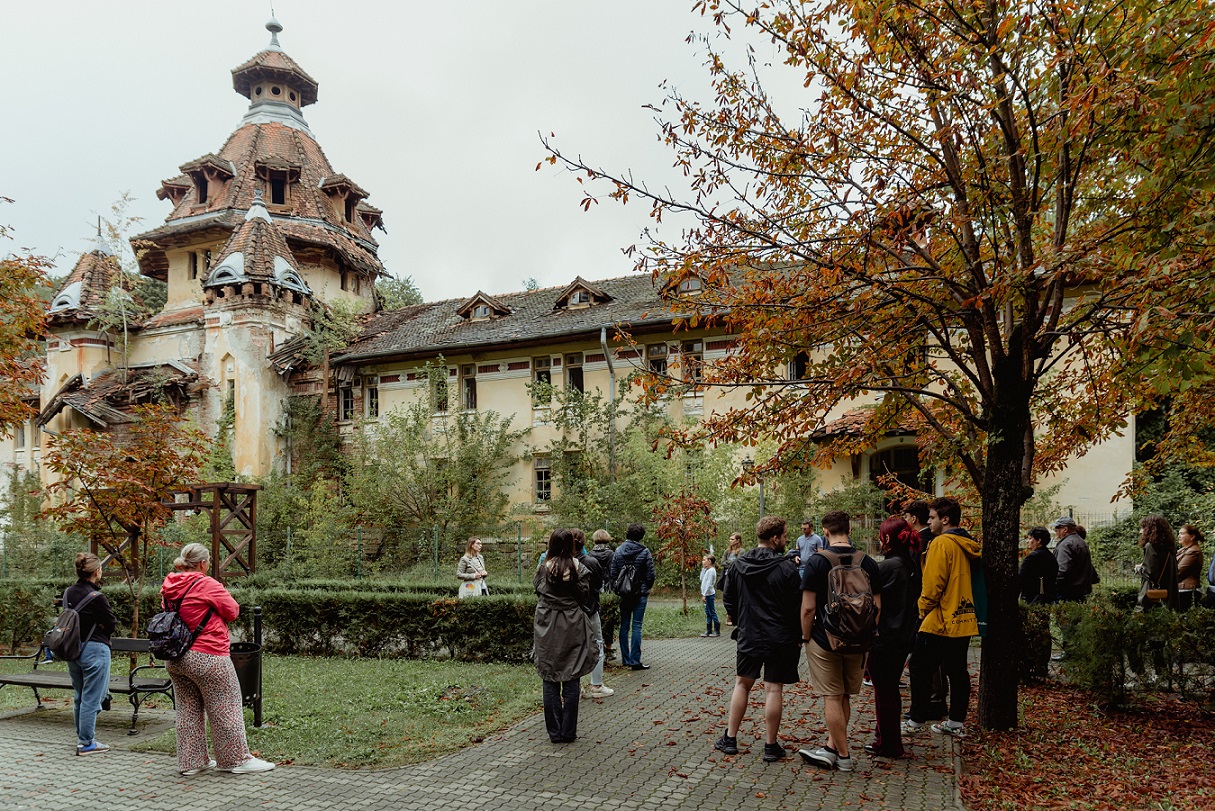
Unlike other resorts, Băile Govora saw fewer new constructions in the 1980s, and it kept much of its initial configuration. How much of this is currently put to use? Where would there be room for development/ improvement?
The uniqueness of Govora lies in the fact that the resort was created from scratch; there was no settlement before. This meant that the spa core has remained separate from the residential area, which gradually developed to serve the needs of the resort. The need for a town planning scheme was already apparent in the inter-war period, but it was not until communism that it was drawn up. If we analyze the development proposals, the demarcation between the town and the resort becomes obvious, with two different typologies - the resort that must be attractive to a large number of tourists, with quality architecture and adequate facilities, and the town that houses the workforce that serves the year-round operation of the resort, with collective housing made of prefabricated buildings.
The town side began to be developed as early as the 1960s, when the first housing blocks were built. It was not until the 1980s that the resort's development plan was drawn up, which envisaged drastic densification of the urban fabric, with numerous hotels and villas that would have substantially increased accommodation capacity. This happened in most of the historical resorts in the country, but at Govora the plan was never fully implemented. Shortly after the start of the project, the state had to stop the project due to lack of funds, after having built only the Oltenia Hotel, a few apartment blocks and commercial buildings.
Usually, the buildings proposed in the pre-'89 period brought with them a rigidity towards future developments because they were often self-sufficient and massive. The fact that the proportion of this type of building is small in urban areas leaves room for experimentation and development in the spirit of traditional townhouse architecture, always in close relation to the landscape. Govora can thus preserve the romantic and peaceful atmosphere of the old resorts, which were intended for a restricted public, the logic of development with unique architectural objects harmoniously integrated into the local specificity.
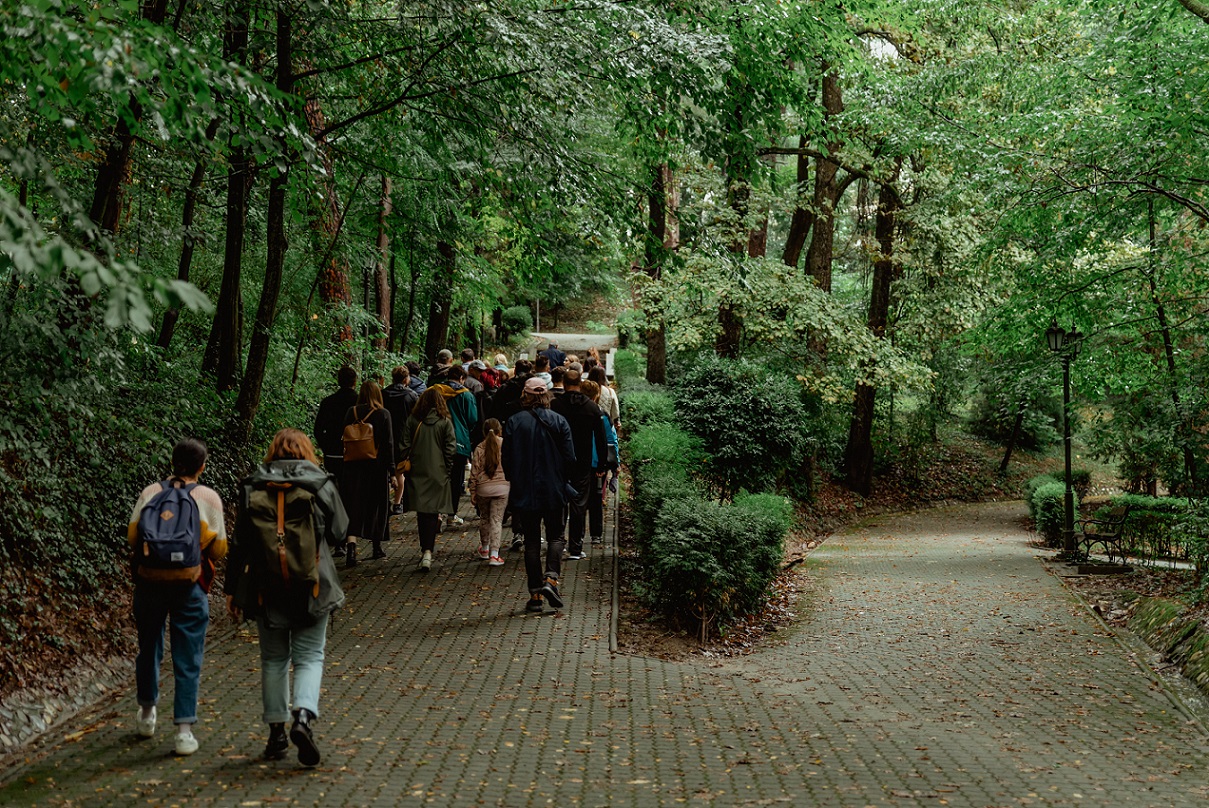
What development opportunities does Băile Govora have? What could the resort become?
We called attention to the spa town starting from a complex topic - its neglected, run-down built heritage and the potential it holds for urban regeneration. It's an issue which requires a lot of local capacity-building, both in public administration and in the local entrepreneurship.
Heritage protection at the local level is also influenced by challenges in the national heritage management system, a chronically underfunded and under-resourced area. Romania has an active and strong civil society focused on the heritage sector precisely because of these shortcomings, but it cannot replace functioning public institutions.
Our conviction is that opportunities lie precisely in the untended and underused built heritage and the surrounding cultural and natural landscape. It would be a waste for the resort town to develop following the model of other spas in the county - Olănești or Călimănești - which are given as examples of success, because it does not have the accommodation capacity given to the others by the great developments of the communist era. In addition, in terms of the quality of construction from recent decades, we cannot say that the nearby resorts are beautiful and pleasant destinations, but rather crowded and cramped.
Govora has the prerequisites for a different kind of growth, where the atmosphere is closer to the historical resorts of the west, with more care for the quality of the buildings and the relationship with the landscape. The resort could stand out for the quality of the public space, pleasant ways to spend time outdoors and alternatives to treatment.
At least one big intervention from the entrepreneurial sphere is needed - an example of good practice in the management of a restored heritage building, contributing both to the local economy and to the quality of life of the local community.
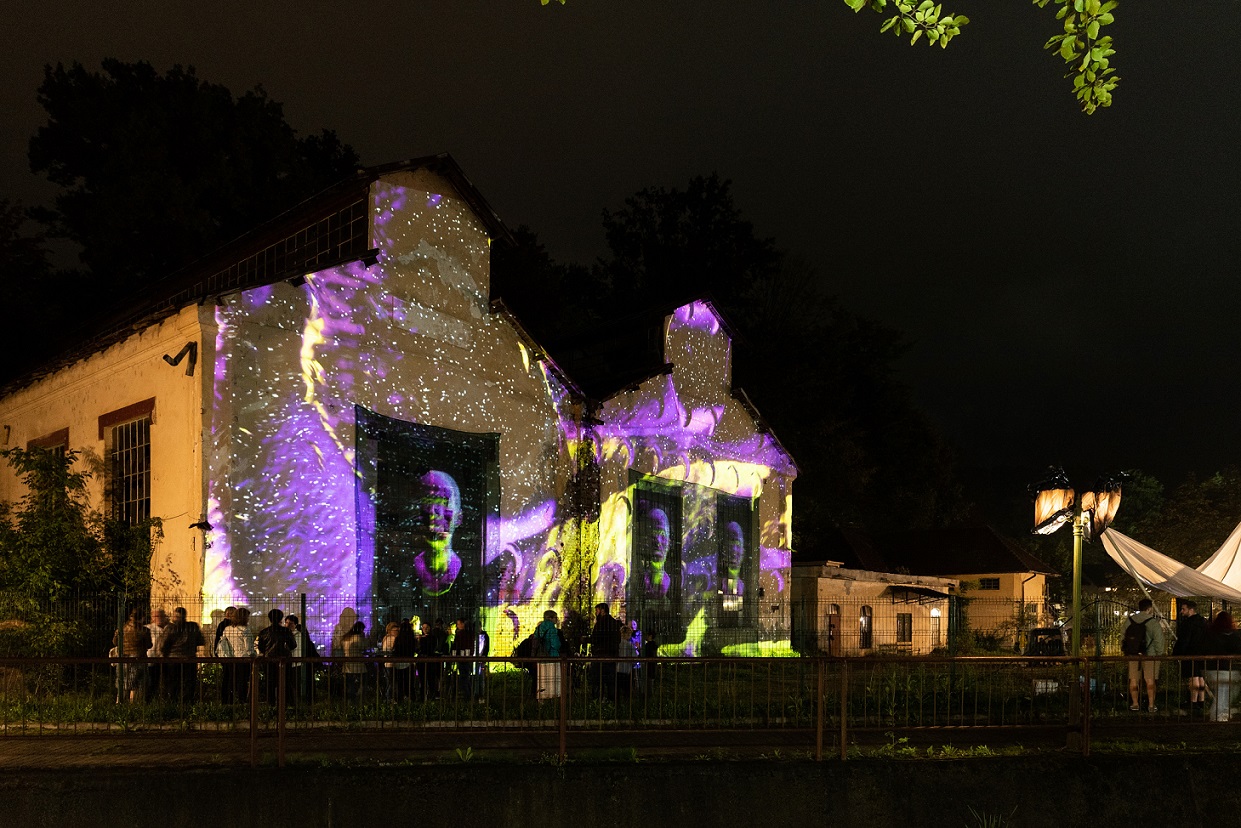
How could tourism develop in the resort? Is there still room for development for balneary tourism? Can Băile Govora attract other types of tourists?
We strongly believe that tourism in the resort can develop, as well as spa tourism at national level. Internationally, there is an increasing emphasis on integrating natural and cultural heritage into the activities of tourists coming to spas. This means developing experiences that are promoted by hoteliers and even recommended as part of the cure program, alongside existing medical practices. Which is not surprising, because spas were conceived, in their 19th century heyday, as beautiful hospitals, where the built and natural environment contributed significantly to the health of those who came for a cure. Govora is located in an area of great natural and cultural heritage: there is UNESCO heritage in Horezu, a few kilometers away, the Oltenia under the mountains Geopark, which aspires to gain UNESCO status, gastronomic events in traditional farms organized by My Secret Romania. In the immediate vicinity of the resort we have superb natural landscapes, gastronomy, vernacular architecture ... Oltenia is a very picturesque area and still underestimated by tourists. Recent research proves that the ideas of doctors a century ago were correct: culture and nature contribute significantly to well-being. Govora can be an ideal place to develop a unique tourist offer for Romania, where heritage makes a measurable contribution to the health and well-being of tourists and residents. Through the Days of Spa Architecture, we have started to work in this direction, but a broader approach is needed, bringing together more initiatives with similar values in the area. We also need the help of medical staff to document the impact that culture and nature have on those who come for treatment.
You organized several events as part of the Spa Architecture Days yearly event. What other projects are you planning for Băile Govora? What does their implementation depend on? What would help you develop them?
Through all that we do, we want to transform the perception of the city and its heritage and move from nostalgia and resignation to immediate action. We have a number of approaches through which we offer advice to owners, including the Guide. We have a program of structural surveys for several buildings and we offer advice on planning interventions. One of the buildings is the Electricity Plant, for which we are working on the restoration project. We want to start the listing procedure for valuable buildings in the city that are not protected and open a series of best practice sites where we can apply the recommendations in the Guide. We want to anticipate the future development of the city and be able to guide it in a direction that takes into account the cultural landscape and we want to use all the legal means available to civil society.
With the network of experts we have access to, we remain a proactive and vigilant partner for local government, which currently lacks this kind of resource. We want to increase this support exponentially, through European cooperation projects that support collaboration with successful international spas that have seen their heritage and cultural balneal landscape as a resource for sustainable development and have already developed tools to this end.
Another plan that we hope will become reality as soon as possible is to have a permanent headquarters in Govora. We want to create a centre for architecture and heritage interpretation, with a bank of historical materials and a restoration workshop, where we can exhibit all our ideas for Govora and work on projects for the development of the resort.
Our plans and ideas need time, resources and a high degree of predictability, especially financially. The Studiogovora team is growing, as is the network of professionals with whom we collaborate, and we remain open to new partnerships. In an ideal scenario, we would benefit from partnerships to secure funding for our projects and bring professional expertise to Govora.
(Opening photo: Marius Vasile, courtesy of Syudiogovora)
simona@romania-insider.com







